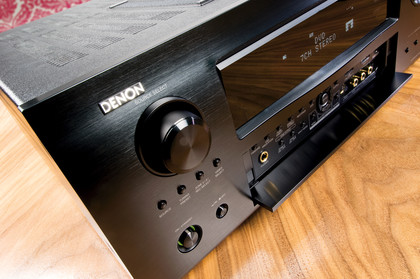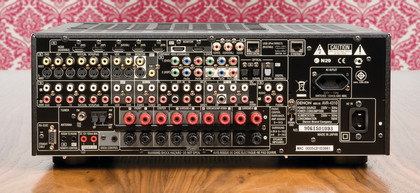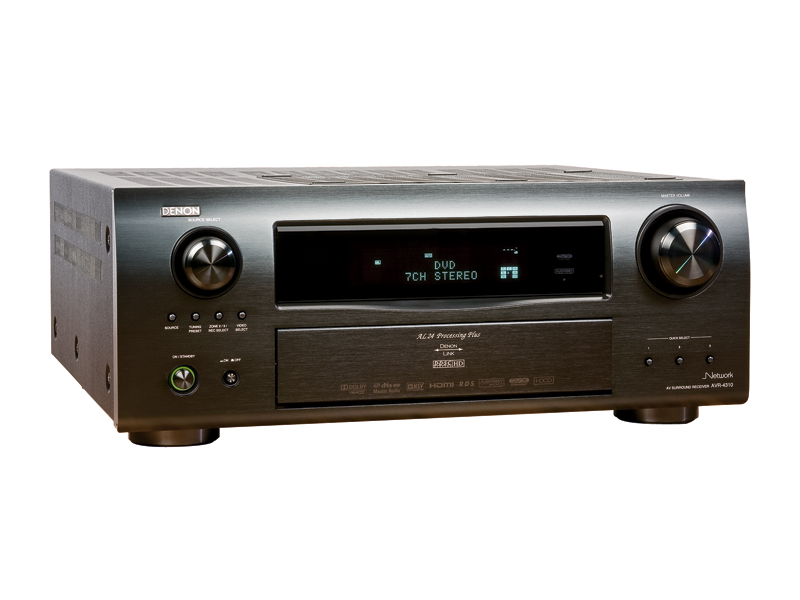TechRadar Verdict
This is a receiver that just gets better and better the more you listen. This is, quite simply, the dog's proverbials
Pros
- +
Awesome sound as standard - DPL IIz and DSX make it more awesome
- +
Packed with features
Cons
- -
No storable configuration modes
- -
No 9.1 output misses the full DSX trick
Why you can trust TechRadar
In the Denon AVR-4310, we have yet another incarnation of Denon's 4300 series networked multichannel AV receiver. Like many of these annual AVRs, you may not notice much of a difference straightaway.
The name has changed, but the face is the same. However, in this case that's no bad thing as the AVR-4308 was a cracker. In fact, other than looking like two peas in a pod (er, black square peas...) there are a number of quite important changes going on beneath that menacing-looking hood.
Denon Link 4th Edition makes its first commercial appearance for better audio link-up with other Denon source products, there is a new Clock Jitter Reducer to improve audio from any HDMI or digital audio input, and you get all new High-Bit i/p scaling for all those ancient analogue video sources you are still hanging on to.
But let's cut right to the chase here – the big news is the world's first implementation of Audyssey's Dynamic Sound eXpansion processing, otherwise known as Audyssey DSX. Forget those rear-back speakers driven by channels six and seven. Implement DSX and enjoy a wider or higher front soundstage with additional speakers up front instead.
If the Audyssey way doesn't float your boat, then the AVR-4310 also offers Dolby's latest Pro-Logic IIz – likewise featuring height-channels as opposed to rear-backs. Not only are both touted as better-sounding than a standard 7.1 set-up, for all those AV aficionados with a doorway, window or opening behind the sofa negating rear-back speakers, this is big news.

Get into the familiar and rather slick Denon GUI and there are a few nice new touches here, too. Most helpful is a new subwoofer level matching routine that engages before the main speaker-by-speaker calibration.
Having bitched regularly about the length of time Denon set-up takes, only to find your sub is set too high and you have to start all over again, this gets a real vote of thanks from me. You get to choose standard 7.1, 5.1 plus Width speakers, or 5.1 plus Height speakers.
The rest of the Audyssey auto set-up is standard fare. Interestingly, the final calculation seems to take a whole lot longer than on previous models – presumably due to do all the number crunching for Audyssey DSX.
Power house
There is plenty of power (130W, claimed) to all channels, of course, plus a comprehensive gamut of HD audio processing and a refreshed, if not radically new, pair of remote controls. I could go on about the ease of network set-up, USB iPod access, the vTuner web-radio server and even the new feature for direct access to your Napster account, but all that is just icing on a really rather fine cake.
The sound of the AVR-4310, straight out of the crate, is great. Not just okay or good in parts, but bona fide great. There's some guy in Japan responsible for tuning Denon's receivers of late, and he has got all the audio desires nailed. Put on any action movie (Iron Man was to hand), and the sound is huge, potent and powerful with stupendous bass.
Yet at the same time the 4310 can be as agile and subtle as a really good stereo hi-fi amplifier. Having only just disconnected Yamaha's similarly-priced DSP Z7, the Denon kicks it up the speaker terminals in quite a few areas of auditory delight.
Perhaps if I wanted a little more simplicity in the set-up, a few less tweaks and tricks and perhaps a little more grunt over refinement, I would have a peek at the Z7… then quickly run back to the AVR-4310 to revel in its dynamic dexterity and detailing.
And then there is its Dolby Pro-Logic IIz and Audyssey DSX trickery. Well, Dolby Pro-Logic IIz is an absolute triumph – but not for its use with two-channel matrix sources. The format's real magic is processing height channel information out of all Dolby and DTS formats – even those of an HD persuasion.
And, wow, what a difference. Tony Stark's quick-fire dialogue in Dolby TrueHD is immediately lifted up into the centre of the screen and the whole front soundstage gains a mass of solidity and scale. As he burst out of his captors' cave in the original Iron Man armour, the entire front of the room exploded with three-dimensional sound like I've never heard before. Put it this way, once you have tried TrueHD or DTS HD with added IIz Height, rear-back channels will be a thing of the past.

OUTPUT: Sound goes in, magic comes out
Casting my mind back to Yamaha's DSP amplifiers with their added 'presence' height channels, the difference is a world apart. These modes have always seemed to induce a feint layer of hash and vaguely phasey edge to the front soundstage, and I confess I expected exactly the same from Dolby's version.
By comparison, IIz Height, when added to DD and DTS sound, is rock-solid, precisely-focused and builds beautifully on the whole front-of-stage atmosphere. Through actions, dramas, animated movies and even my growing collection of multichannel BD music discs, I preferred the added IIz height to rear-back channels every single time.
This also goes a long way to justify Audyssey's reasoning behind DSX, suggesting that added channels at the front are a whole lot better for the immersive effect of a film than more at the rear. And Audyssey DSX Height mode is every bit as clean and refined as Dolby IIz Height, and you can adjust the height effect in 10 per cent increments.
I settled for the absolute mid-way setting which offered the best compromise between the additional soundstage height and the front end becoming a little dislocated. But just like IIz Height, when DSX Height is added to TrueHD or DTS-HD soundtracks, the effect is uniformly positive and better overall than a standard configuration 7.1 channel set-up. Now that's already two revelations in one review.
Swapping speakers to reconfigure for Audyssey DSX Width mode is an unfortunate faff. It involves a complete re-set of the receiver from scratch, including re-measuring all the seating positions. And you can't store multiple configurations – so if you want to go back to Height set-up afterwards – it's another re-set job.
Audyssey DSX Width is just as impressive as DSX Height – albeit in a completely different way (well, dimension). Imagine moving your main speakers out about ten feet in either direction, which if your room is anything like mine would be in the garden, and then filling the void between those and the centre speaker with more main L/R sound. Having already had my flabber well and truly gasted by IIz and DSX Height, the DSX Width is another revelation. That's three in a day – too much for a man of my age.
Throughout Iron Man the whole front end soundstage is wider and more enveloping, but never spreads so far that it upsets the critical front end focus. Dialogue remains centre-centre but seems better-projected with more body, and the sheer number of speakers up front adds a greater sense of scale and dynamic impact. This just begs for even more gratuitous use of the volume knob and the Denon rises to the challenge without even a flinch.
Can't get what you want
But for all the flag waving and tooting trumpets, there's one huge snag: I don't want either IIz Height/DSX Height or DSX Width – I want both at the same time. Okay, the AVR-4310 clearly has no power amp modules left for nine-channel sound but a simple line-level output would have let you add an extra stereo power amplifier for the full DSX 9.1 experience. Ultimately, I would choose Dolby IIz Height with Audyssey DSX Width and rear-back channels as well. But I'm greedy.
The AVR-4310 is the best sub £2k home cinema receiver on the market and, if more than seven speakers in the lounge is impractical or outlawed chez vous, it's a no-brainer. But should those of us with spare speakers and tolerant partners wait? Perhaps until next year, when I am guessing that the AVR-4311 might have nine channels to elicit the full-fat Audyssey DSX experience.
Follow TechRadar Reviews on Twitter: http://twitter.com/techradarreview
